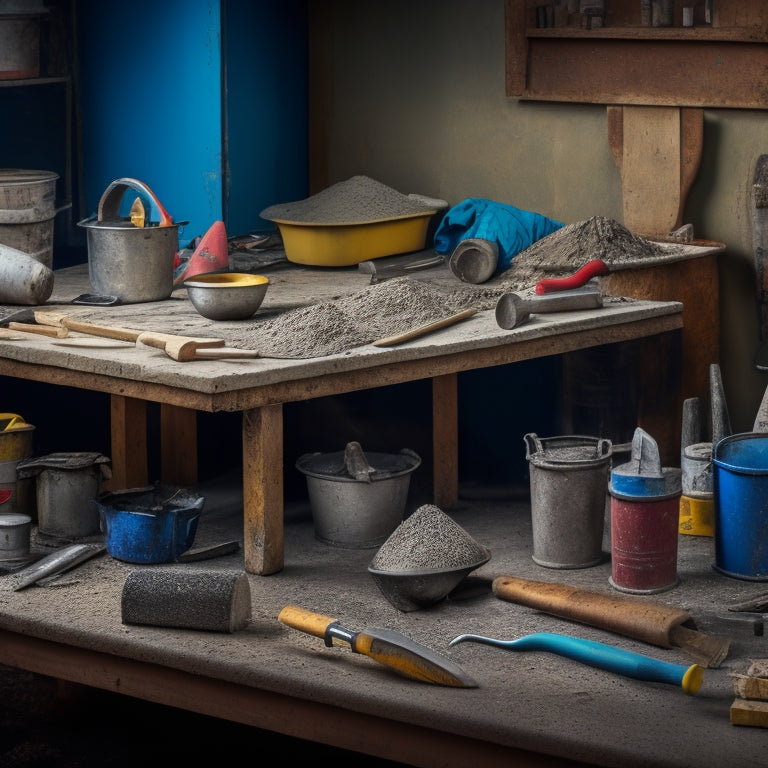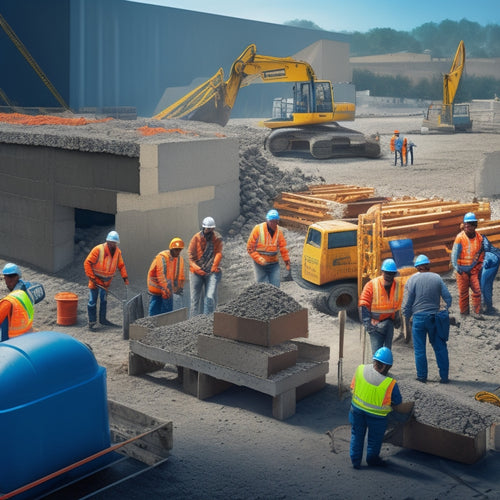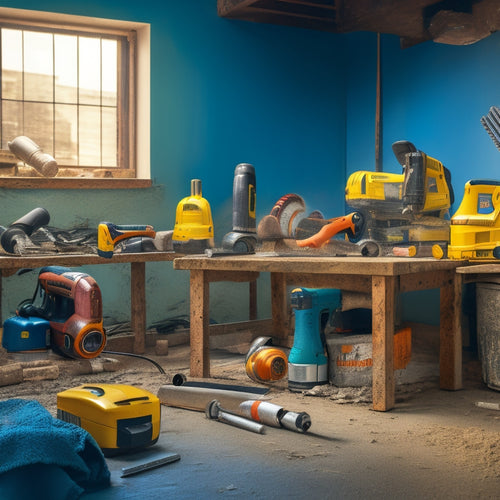
What DIY Concrete Tools Do I Really Need
Share
You'll need a strategic set of DIY concrete tools to achieve a successful project, and surprisingly, the must-haves are fewer than you might think. For mixing, you'll need a sturdy bucket, heavy-duty drill with a mixing paddle, and a tamper to eliminate air pockets. For finishing, invest in a high-quality trowel, floats, and edgers for a smooth finish. Don't forget essential safety gear, including protective clothing, eye and face protection, and a breathing mask. With these basics covered, you'll be well-equipped to tackle most DIY concrete projects - and with a little more insight, you'll be able to tackle even the most complex ones with confidence.
Key Takeaways
• For a successful DIY concrete project, you'll need essential tools like a mixing bucket, heavy-duty drill, and tamper.
• A high-quality finishing trowel, floats, and edgers are necessary for a smooth finish.
• Safety equipment like gloves, protective clothing, eye protection, and a breathing mask are crucial for protecting yourself.
• While specialized tools can be useful, they're not always necessary; prioritize the essentials before investing in advanced tools.
• Consider budget-friendly alternatives like DIY mixers and repurposed tools to save money without compromising on quality.
Understanding Concrete Material Quantities
Calculate the exact amount of concrete you'll need for your project by determining the volume of the area to be filled, as even a small miscalculation can lead to costly waste or, worse, structural instability.
To get it right, you'll need to master concrete volume calculations. This involves measuring the length, width, and depth of the area, and then multiplying these values together to get the total volume in cubic feet. Don't forget to account for any obstructions or irregularities that may affect the volume.
Once you have the total volume, you can use material estimation techniques to ascertain how much concrete you'll need. A general rule of thumb is to add 10% to your calculation to account for any spills or unevenness.
You'll also need to take into account the type of concrete you're using, as different mixes have different yield rates. By accurately calculating the volume of concrete needed, you'll avoid costly mistakes and guarantee your project is completed efficiently.
With practice, you'll become proficient in concrete volume calculations and material estimation techniques, giving you the confidence to tackle even the most complex projects.
Essential Tools for Mixing Concrete
Mixing concrete efficiently requires having the right tools at your disposal, including a sturdy mixing bucket, a heavy-duty drill with a mixing paddle, and a tamper for eliminating air pockets. These essential tools will help you achieve a consistent mix and prevent common issues like segregation and uneven curing.
When it comes to container options, consider using a bucket with a non-stick surface or a mixing tub with a built-in handle for easy pouring.
Mastering mixing techniques is also vital for achieving a high-quality concrete mix. Start by adding the dry ingredients to the bucket, followed by the wet ingredients, and then mix in a circular motion with the paddle.
Be sure to scrape the sides and bottom of the bucket to guarantee all ingredients are fully incorporated. As you mix, use the tamper to eliminate air pockets and achieve a smooth, even consistency.
Finishing Tools for a Smooth Finish
With your freshly mixed concrete in hand, you'll need a set of specialized finishing tools to achieve a smooth, even finish that's free of imperfections and defects. A high-quality finishing trowel is essential for applying and smoothing out the concrete. Mastering trowel techniques takes practice, but it's vital for achieving a professional-looking finish.
You'll also need a float to remove excess water and air pockets, and an edger to create clean, defined edges.
For surface smoothing, you'll require a range of tools, including a steel trowel, a fresno trowel, and a darby. These tools will help you achieve a uniform, blemish-free finish. A steel trowel is ideal for removing small imperfections, while a fresno trowel is designed for larger areas.
A darby is used to flatten and smooth out the surface, ensuring it's even and consistent. By investing in these finishing tools and honing your skills, you'll be able to achieve a flawless, professional-looking finish that will elevate your DIY concrete projects.
Specialized Tools for Complex Projects
When you're tackling complex concrete projects, you'll need specialized tools to achieve unique shapes and designs.
You'll require curved forming profiles to create rounded edges, angled edge creations to add visual interest, and custom molds design to bring your vision to life.
Curved Forming Profiles
Forming curved profiles in concrete requires specialized tools that can accurately shape and hold the complex curves, ensuring a precise and smooth finish.
You'll need to create a template that guides the concrete flow, and that's where curved forming profiles come in. These profiles are typically made of flexible materials like PVC or ABS, which can be bent to fit the desired curve.
To create the template, you'll need to design and fabricate the curved profile using software or manual drafting techniques. This can be a time-consuming process, but the result is well worth the effort. With a well-designed template, you can achieve consistent, high-quality curved profiles in your concrete projects.
For more complex curves, you may need to use multiple profiles or combine them with other specialized tools. By investing in curved forming profiles and mastering template creation, you'll be able to tackle even the most challenging concrete projects with confidence.
Angled Edge Creations
You'll turn to angled edge creations when tackling complex projects that demand precise, sharp angles and crisp shifts between concrete surfaces. These specialized tools are essential for achieving intricate designs and patterns that set your work apart.
To master angled edge techniques, you'll need a range of tools, including angled edge trowels, edgers, and jointers. These tools allow you to create sharp, clean lines and precise angles that add visual interest to your concrete creations.
When working with angled edge techniques, it's vital to have a solid understanding of creative edge designs. This includes knowing how to manipulate concrete to achieve the desired shape and texture.
With the right tools and techniques, you can create stunning patterns, from geometric shapes to organic forms. By combining angled edge techniques with other concrete finishing methods, you can produce truly unique and eye-catching designs.
Custom Molds Design
How do complex designs and irregular shapes factor into your concrete project, and what specialized tools will you need to bring them to life?
Custom molds design requires a deep understanding of mold design techniques and mold material options. You'll need to reflect on the intricacies of your design, taking into account the concrete's flow, pour, and set.
To achieve precise control, you'll require specialized tools like 3D modeling software, a CNC router, or a laser cutter to create intricate mold patterns.
When selecting mold materials, you'll want to evaluate factors like durability, flexibility, and release properties. Silicone, polyurethane, and fiberglass are popular choices, each with its own strengths and weaknesses.
For complex designs, you may need to combine multiple materials or use advanced techniques like multi-part molds or sacrificial molds. Don't be afraid to experiment and push the boundaries of what's possible.
With the right tools and techniques, you can bring even the most ambitious designs to life. By mastering custom mold design, you'll reveal a world of creative possibilities and take your concrete projects to the next level.
Safety Equipment for DIY Concrete
When working with DIY concrete, you'll need to prioritize your safety above all else.
You're about to get hands-on with materials that can be hazardous to your health, so it's vital that you're equipped with the right protective gear.
From essential protective gear to eye and face shields, and breathing mask protection, you'll need to cover all your bases to avoid accidents and injuries.
Protective Gear Essentials
Donning the right protective gear is essential to safeguarding your health and well-being when working with DIY concrete. You don't want to risk skin irritation, respiratory problems, or other injuries that can be prevented with proper protection.
Here are the must-haves for your protective gear arsenal:
| Protective Clothing | Purpose |
| Long-sleeved shirt and pants | Prevent skin contact with concrete |
| Gloves | Protect hands from abrasion and chemicals |
| Closed-toe shoes | Prevent foot injuries from heavy objects |
When it comes to skin protection, you should prioritize covering your skin as much as possible. Long-sleeved shirts and pants will prevent concrete from coming into contact with your skin, reducing the risk of irritation and other skin problems. Gloves will protect your hands from abrasion and harsh chemicals, while closed-toe shoes will prevent foot injuries from heavy objects. Remember, protective clothing is not just a suggestion – it's a necessity when working with DIY concrete.
Eye and Face Shields
You'll need to shield your eyes and face from concrete debris and chemical splashes, which can cause serious injuries, including blindness. This is where eye protection comes in, and it's not just about wearing any old goggles.
The importance of eye protection can't be overstated, as even a small particle of concrete can cause permanent damage to your vision.
When it comes to face shields, you have a few types to choose from. There are full-face shields that provide extensive protection, as well as half-face shields that leave your mouth and nose exposed.
You can also opt for a face shield with a removable lens, allowing you to swap out lenses depending on the task at hand. Whichever type you choose, make sure it's ANSI-approved and designed specifically for concrete work.
Breathing Mask Protection
As you prepare to tackle your DIY concrete project, protecting your lungs from inhaling concrete dust and other airborne particles becomes just as essential as shielding your eyes and face. This is where a reliable breathing mask comes into play. You'll want to choose a mask that can filter out 99.97% of particles as small as 0.3 microns, ensuring you're breathing in clean air.
There are several mask types to evaluate, including half-face, full-face, and disposable masks. Half-face masks cover your nose and mouth, while full-face masks provide additional protection for your eyes. Disposable masks are ideal for one-time use or for projects that don't require heavy-duty protection.
When selecting a breathing mask, assess the air quality you'll be working in. If you're working in a confined space or with particularly hazardous materials, opt for a mask with a higher level of filtration. Look for masks with a NIOSH (National Institute for Occupational Safety and Health) certification, ensuring they meet rigorous safety standards.
Measuring and Testing Concrete Quality
Measure concrete quality by evaluating its consistency, density, and strength, which can be achieved through various testing methods and tools.
You'll need to assess the concrete's slump, which is its ability to flow and fill forms. A slump cone is a must-have tool for this test. Simply fill the cone with fresh concrete, lift it, and measure the resulting slump. This will give you an idea of the concrete's workability and consistency.
Another important aspect of concrete quality is its compressive strength, which is the ability of the concrete to withstand compressive forces. You can test this using a compressive strength tester or a concrete cylinder mold.
These tools will help you determine the concrete's strength in pounds per square inch (psi). You'll need to prepare and cure the concrete samples according to the manufacturer's instructions, then test them at different ages to get an accurate reading.
Budget-Friendly Tool Alternatives
Concrete professionals often rely on high-end tools, but DIY enthusiasts can achieve similar results with budget-friendly alternatives that won't break the bank. You don't need to spend a fortune to get started with DIY concrete projects. With a little creativity, you can repurpose tools you already have or find affordable alternatives that get the job done.
Here are some budget-friendly tool alternatives to take into account:
-
Affordable mixers: Instead of investing in a heavy-duty concrete mixer, try using a drill with a mixing paddle attachment or a manual mixing bucket with a handle.
-
Repurposed tools: Use a trowel or a putty knife to smooth out concrete surfaces, or a level to verify your project is straight and even.
-
DIY screeds: Create a makeshift screed using a straight board and a spirit level to achieve a smooth finish.
-
Budget-friendly tamping tools: Use a hand tamper or a DIY tamper made from a wooden handle and a metal plate to compact concrete.
-
Inexpensive finishing tools: Try using a broom or a rug to create texture on your concrete surface, or a spray bottle to control the amount of water used during the finishing process.
Frequently Asked Questions
Can I Use a Drill as a Makeshift Concrete Mixer?
Can you use a drill as a makeshift concrete mixer? While it's tempting to repurpose your drill, it's not the most effective solution.
Drill limitations become apparent when dealing with thick, heavy concrete mixes. You'll struggle to achieve thorough mixing, which compromises the final product's strength and consistency.
Instead, master proper mixing techniques, such as using a dedicated concrete mixer or a sturdy shovel, to guarantee a smooth, uniform blend.
How Do I Clean and Maintain My Concrete Tools?
When you're done with your concrete project, don't forget to clean and maintain your tools.
You'll want to wash them with soap and water to remove any dried concrete. Use a wire brush to scrub off stubborn bits.
For more thorough cleaning, soak tools in a solution of water and white vinegar.
Regular maintenance tips include lubricating moving parts and storing tools in a dry place.
Are Concrete Tools Different for Indoor and Outdoor Projects?
You're likely used to working with concrete tools that can withstand the harsh outdoor elements, but what about indoor projects?
Surprisingly, the tools you need for indoor and outdoor projects differ greatly.
Outdoor projects require tools that can handle heavy-duty mixing and rough finishing, whereas indoor projects demand more precision and finesse.
You'll need to swap out your rugged outdoor tools for more delicate, specialized ones to achieve a smooth, polished finish indoors.
Can I Rent or Borrow Concrete Tools Instead of Buying?
When considering concrete tools, you're likely weighing the cost of buying versus renting. A cost comparison is essential here.
Rental options can be a cost-effective solution, especially for infrequent or one-time projects. Research local equipment rental shops to explore rates and availability.
Factor in the rental period, tool condition, and potential delivery fees to make an informed decision.
Do I Need to Invest in a Concrete Tool Storage System?
As you hammer away like a medieval blacksmith, you'll soon amass a collection of DIY concrete tools.
But, will you be able to find what you need when you need it?
Investing in a concrete tool storage system is essential for ideal tool organization.
Don't let your workspace resemble a chaotic treasure trove.
Explore storage solutions like pegboards, cabinets, and chests to keep your tools tidy and within reach, saving you time and frustration in the long run.
Conclusion
Now that you've got the scoop on the must-haves for DIY concrete projects, you're ready to get mixing!
Remember, concrete is a temperamental material that demands precision and patience.
Did you know that the ancient Romans used a volcanic ash-based concrete to build structures that still stand today?
With the right tools and a little practice, you can achieve similar durability and beauty.
So, grab your trowel and get to work – your next concrete masterpiece awaits!
Related Posts
-

Essential Power Tools for DIY Concrete Sculpting
As you begin DIY concrete sculpting, you'll need a strategic selection of power tools to achieve professional-grade r...
-

7 Best Tools for Concrete Block Construction
You'll need a solid foundation, precise cutting, and seamless finishing to guarantee your concrete block construction...
-

Essential Power Tools for Concrete Block Construction
When building with concrete blocks, you'll need a range of power tools to cut, drill, mix, and finish the blocks to g...


